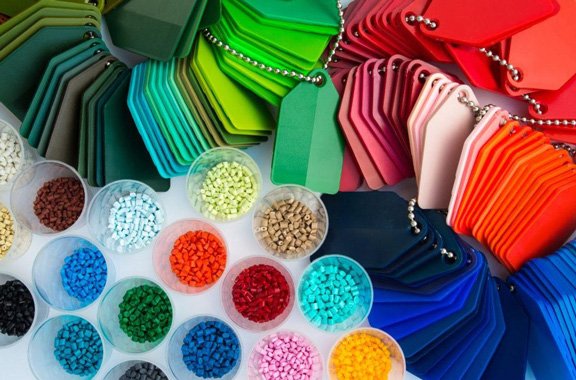Thermosetting plastics or thermosetting polymers are liquid resins at room temperature, these polymers harden with curing agents upon heating process, they have high melting points, and they are cured to a solid state after the processing. Thermosetting plastics can’t be melted back to their original state.
What is cross-linking
The solidification process is a result of the formation of certain bonds called cross-links, that hold the molecules in place and prevent link breaks and melt phenomenon.
Cross-linking is a general term for the process of forming covalent bonds, or relatively short sequences of chemical bonds, to join two polymer chains together. The term curing refers to the cross-linking of thermosetting resins, such as unsaturated polyester and epoxy resin, and such a process of forming chemical links across different thermosetting molecules is called cross-linking(or curing).
What are the differences between Thermoplastics and Thermosetting plastics
Thermoplastics have low melting point, and when heated will soften to a malleable state or melt to a liquid state. This means they can be shaped into any design or mold. Commonly via injection molding or blow molding.
The significant aspect of thermoplastics is their reversibility between solidifying and melting, which bestows the availability of old plastic recycling.Therefore, it’s often the case that all kinds of thermosets have the tendency to connect.
Differences between thermosetting plastics and thermoplastics
The key difference between thermosetting plastics and thermoplastics is their behavior after heating. The melting point of thermoplastic is lower than degradation temperatures, while that of thermosets is higher and they retain a solid shape when thermoplastic melts.
Molecular Structure
Thermoplastics: They are linear polymers, the molecular bonds are weak and are in straight chains.
Themosetting plastic: They are cross-linking together with strong molecular bonds in high density.
Microstructure
Thermoplastics: They are composed of elastic amorphous and hard crystalline regions in the solid state.
Thermosetting plastics: They are comprised of thermosetting resins, and reinforcing fibers in their solid state.
Polymerization
Thermoplastics: Undergo additional polymerization. Polymerized during manufacturing (before processing)
Thermosetting plastics: Undergo polycondensation polymerization. Polymerized during processing.
Recyclability
Thermoplastics are recyclable but Thermosetting plastics are nonrecyclable.
Mechanical Properties
Thermoplastics: Flexible and elastic with increased resistance to impact. And has its strength from crystallinity。
Thermosetting plastics: Inelastic, rigid and strong. It has enhanced ability of bearing pressures from cross-linking.
Solubility
Thermoplastics: Dissolve in organic solvents.
Thermosetting plastics: do not dissolve in organic solvents.
Chemical performance
Thermoplastics: Highly chemical resistance.
Thermosetting plastics: chemical and heat resistant.
Fabrication of thermoplastics
Thermoplastics can be processed in various ways, such as extrusion, injection molding, thermoforming, and vacuum forming. Thermoplastics granules are fed into the mold and then are heated to the melting point at very high temperatures.
Thermoplastics are highly efficient thermal insulators, therefore, rapid cooling is undertaken to achieve a high output rate, usually by spraying with cold water or plunging into the water bath. To cool thermoplastics film, cold air is blown into the surface. The plastics shrink upon cooling. The rate of cooling and shrinkage affects the crystllization of the material and internal structures.

Examples of thermoplastics materials include:
(1)Polyamide(nylon)
Tough and relatively hard material, used for power casing, curtain rails, bearings, gear components etc.
(2)Polyvinylchloride
Tough and durable material, that is used for pipes, flooring, cabinets, toys, household fitting, etc.
(3)Polypropylene
A light and hard material, with excellent chemical resistance, it is used for medical and laboratory equipment, string, rope, and kitchen utensils.
(4) Low-density polyethylene(LDPE).
Tough, relatively soft chemical resistant material. Used for packing toys, plastic bags and film wraps.
(5) High-density polyethylene(HDPE)
Stiff, hard, chemical-resistant material, used for plastic bottles, protective casings, and pipelines. etc
Fabrication of Thermosetting plastics
Thermosetting polymers are processed in their liquid form under heat. The curing process involves adding curing agents, inhibitors, hardeners, and plasticizers to the resin. And reinforcement or fillers, depending on the required outcomes.
The processing of thermosetting plastics involves several key steps. Initially, raw materials such as resins, fillers, and additives are blended to achieve the desired properties and characteristics. This mixture is then subjected to heat and pressure during the molding or shaping process. Unlike thermoplastics, which can be melted and reshaped multiple times, thermosetting plastics undergo a chemical reaction known as curing or cross-linking during this stage. This reaction irreversibly solidifies the material, giving it its final form and properties.
Common methods for processing thermosetting plastics include compression molding, injection molding, and transfer molding. Each method offers unique advantages depending on the specific application requirements. After heated molding, the cured thermoset part may undergo additional finishing processes such as machining, painting, or coating to meet the desired specifications such as hard, stiff, strong, and more.

Examples of thermosetting plastics
- Polyester: Used for laminating, encapsulation, bonding, and casting. Polyester fabrics are one of the popular materials in clothing manufacturing.
- Melamin Formaldehyde: With good chemical resistance. Used for work surfaces, laminates, table wares, and electrical insulation.
- Urea Formaldehyde: Used primarily in electrical devices due to its good electrical insulation properties.
- Epoxy resin: Adhesive and bonding of materials.
- Polyurethane: Hard, strong and durable material. Used in paint, insulating foam, shoes, and car parts. Adhesive and sealants.
The most frequently used thermosetting plastics are these:
U.P: Unsaturated polyester resin
GUP: Polyester resin with fiberglass
BMC: Bulk Molding compound
SMC: Sheet Molding Compound
CSMC: Carbon Sheets Function Component

Other plastics that can be considered thermostable are those plastics reinforced with fiberglass such as PP/GF30, which has polypropylene as its main plastic that has been reinforced with 30% fiberglass.
Elastomers
Its molecular structure comprises linear chains connected that give these plastics great elasticity and flexibility. They withstand high temperatures and considerable deformations and can recover their original length when the heat or applied force ceases. Despite this, they are plastics that cannot be repaired.
In conclusion, both thermoplastics and thermoset plastics play pivotal roles in modern manufacturing across a multitude of industries. Thermoplastics offer versatility through their ability to be repeatedly melted and reshaped, providing flexibility in design and processing. They are widely utilized in applications ranging from packaging to automotive components, owing to their lightweight nature and ease of fabrication. Conversely, thermoset plastics undergo irreversible chemical cross-linking during curing, resulting in superior mechanical properties and enhanced resistance to heat and chemicals. While their processing involves more complex techniques and limitations regarding recycling, thermosets excel in demanding environments where durability and stability are paramount, such as in the aerospace and electrical industries. Both classes of polymers continue to undergo extensive research and development, driving innovation towards sustainable practices, enhanced performance, and expanded applications in an ever-evolving technological landscape. Understanding the unique attributes and processing methodologies of thermoplastics and thermoset plastics is essential for harnessing their full potential in addressing contemporary challenges and advancing toward a more resilient and resource-efficient future.
